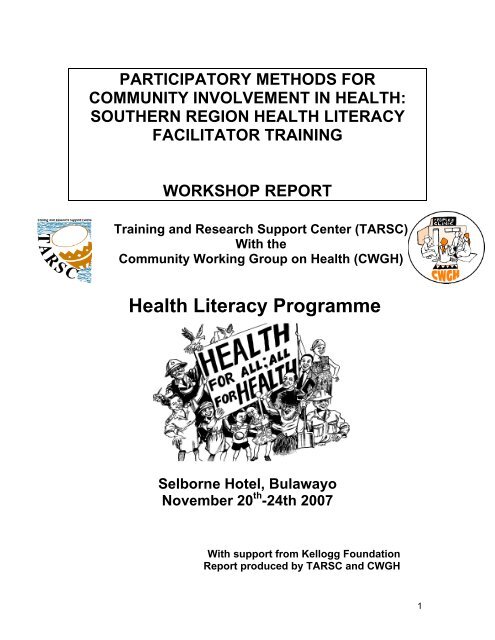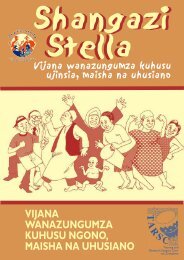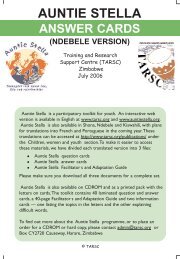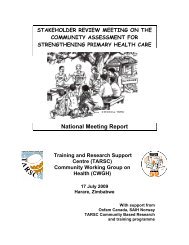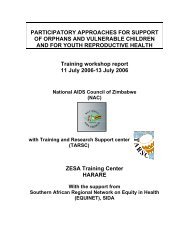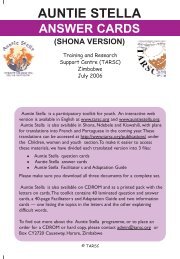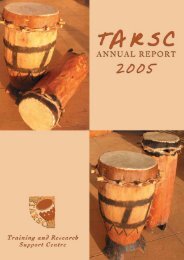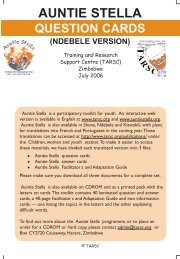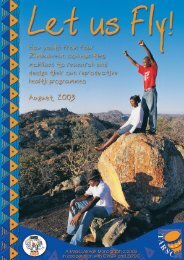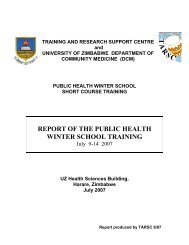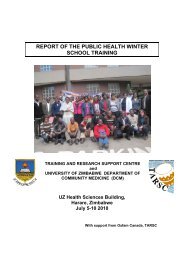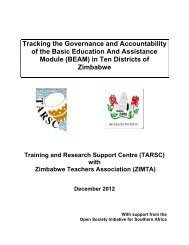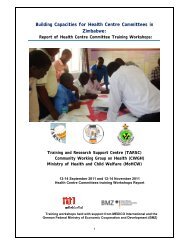HL sthnreg factng rep07.pdf - Training and Research Support Centre
HL sthnreg factng rep07.pdf - Training and Research Support Centre
HL sthnreg factng rep07.pdf - Training and Research Support Centre
You also want an ePaper? Increase the reach of your titles
YUMPU automatically turns print PDFs into web optimized ePapers that Google loves.
PARTICIPATORY METHODS FOR<br />
COMMUNITY INVOLVEMENT IN HEALTH:<br />
SOUTHERN REGION HEALTH LITERACY<br />
FACILITATOR TRAINING<br />
WORKSHOP REPORT<br />
<strong>Training</strong> <strong>and</strong> <strong>Research</strong> <strong>Support</strong> Center (TARSC)<br />
With the<br />
Community Working Group on Health (CWGH)<br />
Health Literacy Programme<br />
Selborne Hotel, Bulawayo<br />
November 20 th -24th 2007<br />
With support from Kellogg Foundation<br />
Report produced by TARSC <strong>and</strong> CWGH<br />
1
Table of contents<br />
1. Background.......................................................................................................3<br />
2. Overview of the health literacy programme.......................................................5<br />
3. The Community Working Group on Health .......................................................5<br />
4. How TARSC works on health............................................................................8<br />
5. Introduction to health literacy <strong>and</strong> PRA.............................................................8<br />
6. Health of communities ....................................................................................10<br />
7. Healthy Environments.....................................................................................12<br />
8. Healthy Nutrition .............................................................................................13<br />
9. Underst<strong>and</strong>ing health systems........................................................................14<br />
10. Community roles in health systems ..............................................................16<br />
11. Next steps <strong>and</strong> closing..................................................................................17<br />
Appendix 1: The programme ..............................................................................21<br />
Appendix 2: The delegates list............................................................................24<br />
2
1. Background<br />
In November 2007, <strong>Training</strong> <strong>and</strong> <strong>Research</strong> <strong>Support</strong> <strong>Centre</strong> (TARSC) <strong>and</strong><br />
Community Working Group on Health (CWGH) under the Regional Health Literacy<br />
programme held a five-day Health literacy facilitator-training workshop. It aimed at<br />
introducing the health literacy programme <strong>and</strong> provide core skills <strong>and</strong> information to<br />
CWGH health literacy facilitators to implement the programme.<br />
The regional health literacy programme in east <strong>and</strong> southern Africa is being<br />
implemented through TARSC Zimbabwe in co-operation with CWGH Zimbabwe, with<br />
MHEN Malawi <strong>and</strong> the Regional network for Equity in health in east <strong>and</strong> southern Africa<br />
(EQUINET). The programme aims to support the development <strong>and</strong> use of participatory<br />
health education materials for health civil society. It is being implemented in Zimbabwe,<br />
Malawi <strong>and</strong> in third country being identified in 2008 with support from Kellogg<br />
Foundation.<br />
This report presents a summary of the proceedings of the 5-day workshop. It<br />
involved facilitators drawn from the academia, private industry, associations, health<br />
institutes, health workers, <strong>and</strong> various governments’ institutions of Zimbabwe under<br />
the CWGH umbrella as listed in Appendix 2.<br />
TARSC <strong>and</strong> CWGH have a history of work on<br />
Participatory Reflection <strong>and</strong> Action (PRA)<br />
approaches in health since 1997 through the<br />
Civic Education Programme on Health. This<br />
programme in the CWGH arose because of<br />
well-articulated dem<strong>and</strong>s for information <strong>and</strong><br />
participation arising from a survey of health<br />
needs <strong>and</strong> the priority strategies in 1998. The<br />
programme <strong>and</strong> materials for it were<br />
developed by TARSC/CWGH members <strong>and</strong><br />
covered public health, health systems <strong>and</strong><br />
organizational issues prioritized by the<br />
CWGH. The programme used participatory<br />
approaches, facilitators were trained from<br />
within CWGH members <strong>and</strong> a facilitator’<br />
guide was provided with the training materials<br />
to support these roles. The CWGH used the<br />
programme between 2000 <strong>and</strong> 2006 to<br />
support district activities, dialogue with health<br />
care providers <strong>and</strong> to strengthen informed<br />
participation <strong>and</strong> joint planning on health<br />
activities. An evaluation of the programme<br />
was carried in 2005 by TARSC with CWGH,<br />
separately reported ([see: TARSC (2005)<br />
Evaluation of the CWGH Civic education<br />
programme on Health TARSC: with CWGH,<br />
Harare Zimbabwe] Discussion of this<br />
evaluation revealed information, capacity <strong>and</strong> skills gaps that would be addressed in the<br />
next stage of health literacy training <strong>and</strong> in the development of a Health Literacy manual<br />
3
[see: TARSC, CWGH (2006) The CWGH facilitators’ review meeting report; 1-2<br />
November; Silveira house- Harare TARSC: Zimbabwe]<br />
The Health Literacy manual was developed by TARSC with input from CWGH, piloted,<br />
peer reviewed, revised, edited <strong>and</strong> finalized (Loewenson R, Kaim B, Machingura F<br />
(TARSC) Rusike I, Chigariro T, Mashingaidze L, Makone A (CWGH) (2007) Health<br />
Literacy guide for people centred health systems: Zimbabwe, TARSC: Zimbabwe)<br />
The criterion for selection of a Health Literacy Facilitator (<strong>HL</strong>F) was determined at the<br />
CWGH board meeting, with characteristics including that the person would:<br />
• Be a member of a CWGH member institution with a district level function- e.g.<br />
committee member, educator, organizer, youth member etc<br />
• Have had experience of working with CWGH for 2 years or more<br />
• Have experience <strong>and</strong> skills in health <strong>and</strong> in education <strong>and</strong> training, preferably<br />
but not essentially, using PRA approaches<br />
• Have good communication skills, is literate in English <strong>and</strong> local languages, has<br />
good facilitation skills, <strong>and</strong> works well with communities<br />
• Not hold other conflicting posts or roles – e.g. formal office in political parties,<br />
formal role managing in health services<br />
• Have flexibility in time <strong>and</strong> work to hold community meetings<br />
The facilitator is expected to facilitate health literacy training for CWGH, facilitate<br />
community dialogue on experiences, <strong>and</strong> encourage reflection on health problems, their<br />
causes, <strong>and</strong> actions. Importantly to obtain, communicate <strong>and</strong> ensure provision of<br />
relevant information on health to communities <strong>and</strong> encourage all relevant stakeholders in<br />
health to communicate <strong>and</strong> take joint <strong>and</strong> informed action on health issues<br />
For this first round of training a total of eleven districts from the Southern districts of<br />
Zimbabwe were covered in the workshop. The workshop covered an introduction to the<br />
CWGH (<strong>and</strong> Module 8), <strong>and</strong> the training in Modules 1,2,3,4,6,7 <strong>and</strong> 8. Module 5 will be<br />
covered in April during the review workshop. Facilitators for different sessions of the<br />
workshop were Fortunate Machingura <strong>and</strong> Senele Dhlomo from TARSC <strong>and</strong> Albert<br />
Makone <strong>and</strong> Tafadwa Chigariro from CWGH.<br />
This report does not go into detail on how the sessions were conducted. The manual<br />
that goes into detail on sessions is separately available. The meeting involved<br />
exchanging experiences, activity, dialogue, reflections, <strong>and</strong> discussions on next steps<br />
<strong>and</strong> follow up. The programme is shown in Appendix 1.<br />
The objectives of the 5-day facilitators training meeting were to<br />
• Introduce the health literacy programme<br />
• Provide core skills <strong>and</strong> information to CWGH health literacy facilitators to implement<br />
the programme<br />
• Work with the health literacy facilitators manual to enable use of the manual in the<br />
programme<br />
4
2. Overview of the health literacy programme<br />
We introduced the Health Literacy Programme <strong>and</strong> the approach that we were going to<br />
use during training. We explained that <strong>Training</strong> <strong>and</strong> <strong>Research</strong> <strong>Support</strong> <strong>Centre</strong> (TARSC)<br />
is currently implementing a regional health literacy programme in East <strong>and</strong> Southern<br />
Africa in co-operation with the Community Working Group on Health CWGH in<br />
Zimbabwe with support from Kellogg Foundation. The programme is developing <strong>and</strong><br />
supporting work with participatory health education materials for health civil society<br />
working at community level <strong>and</strong> aims to build core public health skills in people working<br />
at community level on health.<br />
We highlighted that we would use participatory reflection <strong>and</strong> action methods during the<br />
training workshop tested at regional <strong>and</strong> national level in health. The programme is now<br />
advancing in Malawi <strong>and</strong> Zimbabwe <strong>and</strong> we are hoping to include a third country working<br />
with a partner at community level in Mozambique, Botswana or Lesotho<br />
We began by asking participants about their prior experiences with health educationstrengths<br />
<strong>and</strong> weaknesses. We then highlighted that the strengths will be taken forward<br />
in the Health Literacy programme <strong>and</strong> weaknesses addressed. We went through the<br />
manual together with the participants explaining the flow of modules, links between<br />
information <strong>and</strong> participatory activities, <strong>and</strong> use different sections.<br />
We stressed the importance of merging technical content in the manual <strong>and</strong> the<br />
participatory tools in order to make underst<strong>and</strong>ing of the technical information much<br />
easier as well as taking note of the vital participatory tools that facilitate the process<br />
3. The Community Working Group on Health<br />
We outlined the formation of CWGH, its vision <strong>and</strong> mission. We noted that it was<br />
important for participants to underst<strong>and</strong> the history of CWGH <strong>and</strong> its work, its core<br />
values <strong>and</strong> objectives.<br />
We highlighted that the Community Working Group on Health is a network of<br />
civic/community-based organizations that aim to collectively enhance community<br />
participation in health in Zimbabwe. The CWGH was formed in early 1998 by six civil<br />
society organizations <strong>and</strong> co-ordinated through <strong>Training</strong> <strong>and</strong> <strong>Research</strong> <strong>Support</strong> <strong>Centre</strong><br />
Zimbabwe to take up health issues of common concern. Today, the approximately 30<br />
organizations in the CWGH include national membership organizations that have<br />
branches across the country, while others have areas-specific membership (such as the<br />
residents associations). The CWGH was registered as a trust in 2002 <strong>and</strong> aims to<br />
collectively promote <strong>and</strong> support active community participation in health issues through<br />
advocacy in order to improve the quality of human life in Zimbabwe <strong>and</strong> in the region. It<br />
aims to lead in health advocacy to promote <strong>and</strong> support full community participation in<br />
health issues in Zimbabwe <strong>and</strong> the region.<br />
The Health Literacy programme strengthens some of CWGH’s core values <strong>and</strong><br />
principles, “the Health literacy programme will raise community concerns, issues, <strong>and</strong><br />
positions with health care providers at local <strong>and</strong> central level <strong>and</strong> promote dialogue with<br />
health worker organizations to resolve issues of common concern. This will help to<br />
develop collective positions on policy <strong>and</strong> other issues on health. With such<br />
5
communication, there is assurance of grassroots participation at all levels of<br />
development.” Albert Makone; Monitoring <strong>and</strong> Evaluation officer CWGH.<br />
Participants in their various groups used an illustration/drama as an entry point to show<br />
how the CWGH is organized, strengths <strong>and</strong> weaknesses <strong>and</strong> what actions make the<br />
CWGH stronger at all levels. The illustrations drew out common features of their<br />
experiences…<br />
“Building alliances is very important today; <strong>and</strong> I appreciate the effort put in by the<br />
CWGH secretariat to make new partners <strong>and</strong> in strengthening membership, I would love<br />
to know how new members are selected, what criteria is used,” Alima Milazi; Hwange<br />
Aids Project-Hwange<br />
“Resources given to districts should support some unbudgeted costs faced by the district<br />
committee members especially in this hyperinflationary environment I want to suggest<br />
that the CWGH Monitoring <strong>and</strong> evaluation officer based in Harare submit reports of<br />
activities done, so that we are kept abreast on current achievements <strong>and</strong> commitments,<br />
also-for best practice learning approaches” G. Bepete; Ministry. of Gender-Chiwundura<br />
“from my experience as a community voice activist, <strong>and</strong> also having been part of the<br />
CWGH, I really feel that the secretariat should approve financial requests early. If<br />
communications on the phone or fax are difficult <strong>and</strong> if situations become more<br />
unbecoming like now, we suggest that the secretariat provide a personnel who travels<br />
6
around the districts disbursing cash <strong>and</strong> communicating with the CWGH district<br />
representatives.” Owen Sib<strong>and</strong>a; SPW-Plumtree<br />
“We have a national office that is too busy <strong>and</strong> hardly has time to attend to all districts<br />
needs at urgent times. I think one weakness we have as CWGH is that in our structure<br />
we do not have provincial offices. So, in order to address this weakness, I feel we need<br />
a provincial office that helps to improve communication <strong>and</strong> lessen the amount of work<br />
the secretariat has.” Dumisani Masuku; Min. of Education-Victoria Falls<br />
Some chairpersons at district level have taken so long at the same position; I feel we<br />
need to reshuffle this through a policy, perhaps a policy that says a chairperson should<br />
not serve for consecutive years” Herbert Mhonde; Kwekwe Polytechnic-Kwekwe<br />
From the illustrations, it was clear that the participants understood <strong>and</strong> showed that the<br />
CWGH aims to collectively promote <strong>and</strong> support active community participation in health<br />
issues through advocacy in order to improve the quality of human life in Zimbabwe <strong>and</strong><br />
in the region. It stimulates the formation of local structures for civic participation in health<br />
<strong>and</strong> support informed community participation in local health structures. As such<br />
important to strengthen, the CWGH structures so that these deliverables are met<br />
While describing the CWGH programmes, we briefly outlined the major programmes<br />
(civic education, adolescent <strong>and</strong> reproductive health, HIV <strong>and</strong> AIDS from a gender <strong>and</strong><br />
sexuality perspective) as explained Module 8.2 of the Health Literacy Manual<br />
We displayed all the materials<br />
that CWGH has documented,<br />
based on this material <strong>and</strong> the<br />
participants experiences,<br />
participants commented on<br />
action taken <strong>and</strong> support needed<br />
at different levels in the CWGH<br />
structure<br />
We would appreciate if we could<br />
have a capacity building<br />
workshop in every district once a<br />
new committee is elected”<br />
Moses. M. Ncube; CIVNET-<br />
Tsholotsho<br />
“National members should brief<br />
the district committee on issues<br />
that would have been discussed<br />
at national level that affect the<br />
community” T Mpofu; NCDPZ-<br />
Gweru<br />
‘We would love the CWGH to come <strong>and</strong> support projects that we do we initiate as<br />
community members <strong>and</strong> not necessarily under the CWGH. We are trying to set up a<br />
VCT centre in rural communities, maternal mortality is on the increase yet we often hear<br />
that statistics from the Ministry of health report otherwise. Maternity clinics are often very<br />
far <strong>and</strong> most women do not go for their antenatal visits, they opt to go when they are<br />
seven-months pregnant <strong>and</strong> stay there until they deliver. Often, they are told of their HIV<br />
7
status <strong>and</strong> at this stage little can be done. Furthermore, there is little male involvement in<br />
PMTCT, making it difficult for the mother to reduce her chances of infecting her baby<br />
<strong>and</strong> re-infecting herself. Often, women are found breastfeeding their babies <strong>and</strong> they do<br />
not tell their husb<strong>and</strong>s about the HIV for fear of being hit, divorced or victimised. We<br />
would love it if the CWGH could support the recent domestic violence act, <strong>and</strong> help<br />
women as a vulnerable group. The CWGH could do this by encouraging everyone’s<br />
participation , <strong>and</strong> this will include men who are at this point lost!” G. Bepete; Ministry. of<br />
Gender-Gweru<br />
Participants concluded that it was important that all activities become community based,<br />
participatory, independent, <strong>and</strong> sustainable if action oriented interventions were to<br />
succeed.<br />
4. How TARSC works on health<br />
We looked at the different work areas <strong>and</strong> resources of TARSC. This was through a mini<br />
exhibition whilst participants circulated around the room looking at the literature <strong>and</strong><br />
engaging in discussion with a person from TARSC at each ‘station’/exhibition site. At the<br />
end, participants discussed in plenary on how TARSC’s work supports <strong>and</strong> deepens the<br />
activities of organizations such as CWGH. Hence, complimentary work in areas of<br />
reproductive health through the auntie Stella toolkit used by the CWGH Youth<br />
Programme, the PRA toolkit used in several participatory projects within the CWGH, the<br />
Health Literacy Manual that will be used in many Health literacy projects in the country ,<br />
the Community Based <strong>Research</strong> <strong>and</strong> <strong>Training</strong> Programme provides research support to<br />
the health basket monitoring <strong>and</strong> so on. Examples of how TARSC supports CWGH in<br />
research, training, <strong>and</strong> other work were highlighted.<br />
5. Introduction to health literacy <strong>and</strong> PRA<br />
5.1 Using PRA approaches in health<br />
Participants were given a short introduction to PRA, the facilitator asked participants to<br />
break into groups to share their experiences in participatory approaches <strong>and</strong> to list the<br />
key features of a participatory process/ experience<br />
During plenary, the following common themes emerged:<br />
• Collective <strong>and</strong> active involvement of everyone in the community<br />
• Collective action- ownership of the program <strong>and</strong> empowerment<br />
• Need for monitoring <strong>and</strong> evaluation<br />
• Problem identification <strong>and</strong> empowerment<br />
• The community needs to address their needs in order of priority<br />
All of the groups identified the need to come up with solutions. The facilitator stressed<br />
the need rather to come up with action plans <strong>and</strong> noted that in order to collectively move<br />
towards action plans participatory tools are needed.<br />
8
A health literacy<br />
facilitator is expected to<br />
facilitate processes in<br />
the community <strong>and</strong><br />
ascertain that the spiral<br />
model is understood as<br />
communities reflect,<br />
meet to discuss <strong>and</strong><br />
share experiences <strong>and</strong><br />
act on priority health<br />
needs while weaving<br />
this with the health<br />
literacy information.<br />
Participants highlighted<br />
that there is need for<br />
health literacy<br />
facilitators to be<br />
attentive, to listen, to<br />
talk less, prepared to<br />
learn new things from<br />
communities <strong>and</strong> not to<br />
present themselves as<br />
experts.<br />
.<br />
5.2. Approaches to health literacy- using PRA in health<br />
We looked at two case studies in the manual <strong>and</strong> analyzed the actions taken by<br />
communities for each case study. We identified what made the actions successful <strong>and</strong><br />
what made them fail. We gathered that successful participatory action by all<br />
stakeholders (social groups) is important in all interventions at community level.<br />
In plenary, we agreed that health literacy requires the ability to improve health that often<br />
depends on underst<strong>and</strong>ing the causes of health problems then encouraging dialogue<br />
between the public <strong>and</strong> health services on these problems <strong>and</strong> how to deal with them.<br />
Often, this is be accompanied by feedback from health services on how they are<br />
addressing health issues. We concluded that iimproving health goes beyond simply<br />
knowing about health. It is about being able to take effective action. As such, we are<br />
choosing health literacy over health education because it goes beyond giving<br />
information, to supporting action. We highlighted that supporting action was depended<br />
on community participation <strong>and</strong> effective resource mobilisation <strong>and</strong> that these two<br />
complimented each other<br />
Participants had mixed feelings when they were asked how they felt when they<br />
facilitated <strong>and</strong> when someone else was facilitating. Some felt that it was challenging to<br />
facilitate whilst some enjoyed the process. Some participants felt neglected when there<br />
was someone dominating the group, other interesting views pointed at ways to make<br />
passive participant who lacked self-confidence participate. Rappoteuring was viewed as<br />
a boring <strong>and</strong> difficult role, it needs someone who concentrates <strong>and</strong> who is a good<br />
listener <strong>and</strong> able to follow the discussion <strong>and</strong> write at the same time. We highlighted that<br />
9
a Health Literacy facilitator should be conversant with all these roles as they compliment<br />
each other.<br />
6. Health of communities<br />
Four pictures were put on the wall <strong>and</strong> participants were asked to comment if the people<br />
on the pictures were healthy, why they were healthy or not healthy. This session enabled<br />
us to underst<strong>and</strong> that health is not only the absence of disease but also a combination of<br />
many other factors. This session was found to be quite relevant in empowering<br />
communities as it is the backbone for promoting health <strong>and</strong> motivating action within<br />
communities. We resolved that Health is a multi-faceted <strong>and</strong> cannot be described by one<br />
aspect of well being; we used the WHO definition of Health as in the manual to illustrate<br />
the meaning of Health.<br />
When we had all agreed that<br />
heath is multi-dimensional,<br />
we explored how different<br />
communities <strong>and</strong> social<br />
groups react <strong>and</strong> underst<strong>and</strong><br />
heath differently. We<br />
discussed the components<br />
that define communities <strong>and</strong><br />
how we underst<strong>and</strong><br />
‘community’ consequently,<br />
we explored how we<br />
underst<strong>and</strong> ‘social groups’.<br />
Fictitious social maps were<br />
drawn representing fictitious<br />
communities with features<br />
that directly or indirectly<br />
influence health of different<br />
social groups.<br />
We explored the transect<br />
walk. “I think the transect walk is more practical in clustered settlements <strong>and</strong> urban<br />
communities, not in sparsed settlements in some rural areas, it would otherwise be very<br />
impossible unless we can do it in a moving vehicle to observe a range of features,<br />
resources <strong>and</strong> conditions in the area, it that case I would then call it a transect drive!<br />
Jotham Mutemeri; GAPWUZ-Gweru<br />
We agreed that mapping is usually an entry point of a health literacy facilitator into a<br />
community; it enables the facilitator to underst<strong>and</strong> problems associated with social<br />
groups in that community.<br />
It is important in Health Literacy programmes to identify <strong>and</strong> prioritize health needs. We<br />
explored ways in which these needs could be prioritized through the ‘ranking <strong>and</strong> scoring<br />
method’. Three different groups, men, women <strong>and</strong> youth, identified their priority health<br />
problems. An example from the men’s group is given below:<br />
10
What is your health problem Score Rank<br />
Unavailability of drugs 3 5<br />
Stress 7 2<br />
HIV/AIDS 6 3<br />
Food insecurity 8 1<br />
Shelter 5 4<br />
We compared the above list<br />
with the top ten out patient<br />
conditions in Zimbabwe in<br />
2002. We saw that there<br />
were huge differences. For<br />
example the number one<br />
problem according to the<br />
Ministry of Health was ‘acute<br />
Respiratory infections’ with a<br />
total of 25.8% of total new cases in 2002 alone The health worker priorities are clearly<br />
different from community priorities. We explored reasons why there were such huge<br />
disparities <strong>and</strong> the following is what the participants concluded<br />
• The methods used in determining the most priority condition or problems are not<br />
people centred<br />
• Data collection does not represent the whole population as such not all<br />
demographic variables are considered.<br />
• Some social groups are left out e.g. children <strong>and</strong> infants<br />
• The economic environment has made many social groups poorer, most do not<br />
visit hospitals <strong>and</strong> clinics were most of this data is captured from. The community<br />
voice is silent in those statistics<br />
• The question is who prioritizes those health conditions the health provider of the<br />
communities? Clearly, it is the health provider; the information resembles the<br />
provider’s perceptions on what the priority health conditions are.<br />
• Data is not captured regularly; the data in the manual is 2002 data, which makes<br />
it difficult to compare with today’s problems.<br />
11
7. Healthy Environments<br />
We briefly talked about the constitution of Zimbabwe, participants were advised to learn<br />
more about the constitution so that they converse well with it <strong>and</strong> are able to apply or<br />
quote from the constitution <strong>and</strong> when addressing issues that are related to it.<br />
The constitution reveals that people have a right to life, the Public Health Act supports<br />
the constitution <strong>and</strong> the right to health, <strong>and</strong> participants were encouraged to get the<br />
public health act <strong>and</strong> be acquainted with it so that they are able to give reference to it.<br />
Participants also suggested some issues that should be considered in the Zimbabwean<br />
‘constitution, examples include the following<br />
“Ministry has a policy on essential drugs there is need for a clause in the constitution that<br />
defines the issue of essential drugs”<br />
“There should be a clause in the constitution that specifies the amount of coli forms that<br />
can be accepted in water for it to be rendered safe for drinking “<br />
We explored characteristics of an environment that promotes well being <strong>and</strong> examples<br />
included toilets/waste disposal, water, cleanliness, social facilities e.g. playing ground,<br />
decent accommodation. We discussed consequences of water privatization drawing in<br />
from participants experiences, the following are some remarks on the effects of water<br />
privatization…<br />
“i am from a rural district, sometimes we sacrifice to go for years without enough saving<br />
for boreholes, then once you have the borehole you are required to pay some money to<br />
ZINWA every month, I don’t underst<strong>and</strong> why I have to pay for water at a rural<br />
homestead” D Rumona; VHW-Chiwundura<br />
“in Kwekwe, we are in the process of finding alternative ways to curb cholera outbreaks.<br />
These outbreaks have been caused by a permanently burst sewer pipe, which has<br />
caused many diseases other than cholera. What’s surprising is that we pay monthly to<br />
ZINWA to correct such <strong>and</strong> they never come, we often wonder where our money is put”<br />
M C Mukamuri; Min Of Education-Kwekwe<br />
“Commercialization of water is leaving families broke, food insecure <strong>and</strong> poorer than<br />
before. This is because we are paying twice for the same service. We pay for water<br />
when we pay tax, then we pay again through ZINWA, it is just unfair. Noth<strong>and</strong>o Moyo;<br />
Plum tree AIDS Project-Plum tree<br />
We discussed several ways in which the CWGH could get involved, <strong>and</strong> reiterated that<br />
when facilitators have gone back to their districts they should hammer on drawing out<br />
issues from community experiences then add new information where necessary <strong>and</strong><br />
beginning planning for action before the actual implementation.<br />
In relation to this, we laid seven pictures on the floor <strong>and</strong> asked three volunteers to sort<br />
the pictures into three piles, BAD, GOOD, or NEUTRAL. Other members agreed whilst<br />
others disagreed on the decisions the volunteers had made on the pictures depiction of<br />
effects on environmental diseases in the community. After several discussions around<br />
what <strong>and</strong> how diseases spread from unsafe water <strong>and</strong> sanitation in our community, the<br />
12
pictures were resorted. Diseases discussed included diarrhea, cholera, malaria followed<br />
by diseases spread through overcrowded or unsafe housing such as Tuberculosis.<br />
These discussions informed development of action plans that communities can develop<br />
when dealing with Healthy environments in their communities.<br />
We discussed approaches to dealing with diseases arising from unsafe environments.<br />
We highlighted the five-stage approach as given in the example below<br />
1. Look for <strong>and</strong> identify the source of the problem<br />
2. Control the problem at the source - for example if it is unsafe water due to an<br />
uncovered well, cover the well <strong>and</strong> introduce a h<strong>and</strong>pump<br />
3. Control the problem along the path way – for example using bed nets to stop<br />
mosquitoes reaching <strong>and</strong> biting people<br />
4. Screen people who might be exposed to the problem- for example screening<br />
urine for blood to detect bilharzias, treat it <strong>and</strong> avoid further spread<br />
5. Treatment<br />
For example, in the case of an outbreak of bilharzias:<br />
Look for the source: The disease is introduced by urinating<br />
in the river<br />
Control the source; People need toilets, build toilets; People<br />
need to get education on how bilharzias is spread, effects of<br />
bilharzias, prevention <strong>and</strong> control<br />
Break the path way <strong>and</strong> control on the pathway:<br />
Eliminating the infected snail population by using<br />
molluscicides<br />
Screen people: Look for signs <strong>and</strong> symptoms such as blood<br />
in urine<br />
Treatment: treat those with positive signs <strong>and</strong> symptoms of bilharzias<br />
8. Healthy Nutrition<br />
We reviewed what we mean by food security <strong>and</strong> food sovereignty in buzz groups.<br />
Participants knew there was a difference but could not draw the line between the two.<br />
As we discussed <strong>and</strong> shared experiences we all began to underst<strong>and</strong> the relationship<br />
between the two but also noting the differences. These concepts are described in the<br />
<strong>HL</strong> manual.<br />
The issue of ‘quality <strong>and</strong> quantity’ was common for both concepts, as participants kept<br />
referring to ‘enough, balanced, nutritious’ food. This led us into an engrossing debate on<br />
the healthiness of the foods we eat through a three pile sorting approach. In this<br />
discussion, we emphasized more on major nutrients, how best we can extract them in<br />
their natural form <strong>and</strong> without losing them through overcooking <strong>and</strong>/or processing.<br />
Consequently, we discussed what happens to people when they do not get adequate<br />
13
healthy food using an illustration in the manual of a well-being map <strong>and</strong> how to monitor<br />
nutrition in the community using examples such as the Shakier strip. In addition, we<br />
talked about selecting foods that are locally available <strong>and</strong> highly nutritious such as<br />
beans for children as a special vulnerable social group. Other social groups that we<br />
discussed include People Living with HIV <strong>and</strong> AIDS, Expecting mothers, old aged<br />
people, manual workers, infants. An example of nutritional needs for one of the groups<br />
is as follows….<br />
What do you think Pregnant mothers should eat <strong>and</strong> why?<br />
“When I was pregnant with my first baby my mother in law often said I should eat for two,<br />
have a diverse diet that is rich in energy <strong>and</strong> micronutrients, I would eat a lot of energy<br />
giving foods like potatoes, sadza, rice <strong>and</strong> cassava with vegetables such as rape <strong>and</strong><br />
pumpkin leaves. The vegetables are good sources of micro nutrients such as iron” Arleta<br />
Dube, NAC, Tsholotsho<br />
‘I often see many women nowadays being encouraged to eat Carrots for vitamin B,<br />
liver <strong>and</strong> spinach for iron, beef <strong>and</strong> chicken for protein. Physician always encourage<br />
expecting mothers to eat a lot of protein to build new cells for the growing baby:” Agnes<br />
Mamvura; CHBC-Kwekwe<br />
“I ate a lot of butternut, pumpkins <strong>and</strong> carrots, a nurse at the antenatal classes told me<br />
that yellow vegetables were good for good eye sight for my baby’” Mary Jokoza<br />
Sundami, Zimbabwe Women Farmers Federation Association-Chiredzi<br />
“I have always hated fish, but whenever im pregnant I eat fish, my gynaecologist told<br />
me that fish has oils that are important for my bay’s brain development, <strong>and</strong> all my<br />
children are very intelligent.” M C Mukamuri; Min Of Education-Kwekwe<br />
The contributions were rich <strong>and</strong> informative. We closed the day with a reflection of the<br />
day on lessons learnt, outst<strong>and</strong>ing questions, <strong>and</strong> whether modules in the manual<br />
provided enough tools to be able to strengthen the link between knowledge <strong>and</strong> action at<br />
community level. We also reflected on what additional support <strong>and</strong> information<br />
participants would need to facilitate sessions on these modules. Feedback on what was<br />
learnt was generally good <strong>and</strong> positive.<br />
9. Underst<strong>and</strong>ing health systems.<br />
We began by discussing Primary Health care in relation to the health delivery system.<br />
What is the health delivery system made up of <strong>and</strong> how should the different components<br />
relate in order to have an equitable strengthened health delivery system? Is this what is<br />
happening?<br />
We took the example of a young man who had been hit by a car <strong>and</strong> rushed to the clinic.<br />
Would he be given enough attention? Would he be supported? How would the family<br />
support him? We made a human sculpture of how we think our health systems currently<br />
respond.<br />
14
For example,<br />
• the health workers ignored the young man who was bleeding to death…<br />
• he was with his mother in pain (lack of support)…<br />
• The nurse was busy on the phone …<br />
• The clerk was busy telling stories with the general h<strong>and</strong>…<br />
• The Doctor was far away from the scene…<br />
• There were no drugs<br />
• Other patients in the queue looked tired <strong>and</strong> hopeless…<br />
• There was no transport to ferry the patient to the hospital….<br />
• The resources were far<br />
away in the Ministry of<br />
health (too much<br />
beaurocracy)…<br />
• The ministry of health<br />
was not aware of what<br />
happens at clinic<br />
level…<br />
• The parliament was<br />
high up on the chair<br />
<strong>and</strong> communication<br />
was impossible from<br />
clinic level….<br />
• The IMF <strong>and</strong> other<br />
donors only cared<br />
about money, <strong>and</strong> how<br />
much loaned given to<br />
which country at what<br />
interest rate, or at what<br />
benefit<br />
After this, we moved the<br />
human sculpture around until it<br />
looked more like what we<br />
thought people centered health systems should look like. There were many differences<br />
after turning around the Human sculpture<br />
• The young man was at the centre of the health system (continuum of care)<br />
• The family was being supported by other structures in the community, such as<br />
the police the CWGH,<br />
• The health workers were more involved, prepared to listen, supportive <strong>and</strong> ready<br />
to give aid (more dialogue <strong>and</strong> communication)<br />
• There were drugs <strong>and</strong> other resources at the clinic <strong>and</strong> better links <strong>and</strong><br />
communication with other levels in the health delivery system<br />
• The ministry of health had a clear picture of what happens at clinic level <strong>and</strong> work<br />
centered on supporting the structures <strong>and</strong> people at the clinic<br />
15
• The IMF <strong>and</strong> other donors though far away from the clinic were putting people<br />
first before profits<br />
• The health system was more people centred<br />
From this sculpture, we discussed attributes that make health systems people centered,<br />
<strong>and</strong> that turning this around meant empowered communities that are able to take action<br />
of their own health problems, we re-emphasized the concept of health literacy once<br />
more! Furthermore, we strengthened the lessons from the Human sculpture with lessons<br />
learnt from a talk show around ways in which health systems respond to social<br />
differences in traditional services <strong>and</strong> youth friendly services. We were also able to<br />
discuss factors facilitating or hindering the utilization of the health systems by<br />
communities. One of the factors looked at the relationship between communities <strong>and</strong> the<br />
health workers.<br />
As a result, we brainstormed on health workers, push, <strong>and</strong> pull factors <strong>and</strong> how Health<br />
Workers relate to the community <strong>and</strong> vice versa. We used the Margolis wheel to explore<br />
<strong>and</strong> strengthen communication between health workers <strong>and</strong> communities <strong>and</strong> to find<br />
ways to involve health workers in the <strong>HL</strong> meetings<br />
Communities <strong>and</strong> health workers blame each other for the collapsing health system<br />
some of the comments raised include the following…<br />
Communities<br />
• Health workers take<br />
communities as uneducated<br />
people who know nothing <strong>and</strong><br />
view themselves as highly<br />
educated, they forget that some<br />
of the community members they<br />
treat are actually professors<br />
who teach medicine!:<br />
• ‘Nurses are busy pursuing other<br />
interests at work instead of<br />
attending to patients..’<br />
• ‘Doctors <strong>and</strong> nurses are rude to<br />
patients…’<br />
Health workers<br />
• ‘Most community members<br />
forget that from another angle<br />
we are also community<br />
members <strong>and</strong> we have rights<br />
just like themtake us for granted<br />
<strong>and</strong> do not respect us…’<br />
• some patients make it difficult<br />
for us, they think we rae<br />
supposed to stay even if<br />
conditions of stay are not<br />
supportive.<br />
We realized that it is important that both communities <strong>and</strong> health workers work together<br />
from planning level. It is therefore essential that during Health literacy activities<br />
communities involve health workers <strong>and</strong> local leadership to strengthen communication in<br />
health systems.<br />
10. Community roles in health systems<br />
Through dialogue <strong>and</strong> effective communication, we realized that health workers <strong>and</strong><br />
communities have important roles to play in health systems. We used “where’s Wadzai’<br />
concept to show the important roles the community can play to strengthen health<br />
systems. The activity is illustrated in the Health Literacy manual page 125-127.<br />
16
We explored the role of Health Center committees <strong>and</strong> current health planning<br />
mechanisms such as district development committees <strong>and</strong> rural district councils, <strong>and</strong><br />
how well they be used to strengthen Health systems.<br />
We used a wheel chart as a way of exploring how health systems listen to people’s<br />
views. The manual provides further information on this. The wheel chart helped to<br />
explore views on reasons why the health systems do not listen to people by looking at<br />
the current situation <strong>and</strong> what should be. We discovered that there is an urgent need for<br />
wider engagement in health if strong health systems are to st<strong>and</strong> firm. Engaging with key<br />
institutions is key in ensuring community health needs are met. We identified groups,<br />
institutions, <strong>and</strong> individuals involved with health issues who should be engaged in health<br />
systems. Furthermore, we explored the role of civil society in ensuring local action<br />
addresses community priority needs. We did this by looking at the priorities adopted by<br />
health civil society groups at the Southern African Social Forum in Zimbabwe 2006. We<br />
explored the important priorities in relation to what was happening in communities to<br />
address these priorities in reclaiming resources for health <strong>and</strong> building people centered<br />
health systems, what still needs to be done <strong>and</strong> how. We wrapped the day by another<br />
reflection exercise.<br />
11. Next steps <strong>and</strong> closing<br />
We began by discussing how we would set up a community Health Literacy programme.<br />
We discussed the importance of drawing both a facilitator plan <strong>and</strong> a community plan<br />
<strong>and</strong> what each should include. Detail on facilitator <strong>and</strong> community plans are at the end of<br />
each module in the manual. Participants were reminded that training on Module 5<br />
‘Health life cycles’ would be done in April 2008 during the review meeting. We<br />
emphasized that when participants develop their work plans, they should consider<br />
including core modules. Participants went into groups where they discussed <strong>and</strong><br />
developed Community Health Literacy Programs for their districts. These work plans<br />
were to specify ‘Who will come to the Health Literacy session in terms of both<br />
participants + facilitations; when these sessions would be held? For how long <strong>and</strong> how<br />
long before the next session? How many sessions between now <strong>and</strong> feedback session<br />
set for January 17 2008?<br />
The following is an example of a community plan –Chiwundura District<br />
Where Who When <strong>Support</strong> Module<br />
From this Health Literacy workshop, we will go <strong>and</strong> make contact with other CWGH<br />
committee members <strong>and</strong> set a date for a meeting. In this meeting, we will discuss the Health<br />
literacy facilitator training workshop <strong>and</strong> what we intend to do in the community as Health<br />
literacy Facilitators.<br />
Muchakata<br />
CWGH<br />
Committee<br />
members<br />
11/12/07<br />
10-1200hrs<br />
Transport<br />
reimbursements,<br />
refreshments <strong>and</strong><br />
snacks<br />
Feedback<br />
We will begin to notify the chief, the councilor <strong>and</strong> other important stakeholders, including<br />
some community representatives about the Health literacy workshop that we will hold, at<br />
specified date, time <strong>and</strong> venue<br />
Muchakata Mobilization 17 /12/07 Transport Organize workshop<br />
17
<strong>and</strong><br />
sensitization<br />
meeting<br />
1000-<br />
1200hrs<br />
reimbursement<br />
s, refreshments<br />
<strong>and</strong> snacks<br />
We will put fliers around schools, shops, beer halls, shopping centers, <strong>and</strong> schools about<br />
the health literacy workshop.<br />
Muchakata All key<br />
stakeholders<br />
Local<br />
authorizes<br />
Community (all<br />
social groups)<br />
10<br />
/01/08<br />
0900-<br />
1300hrs<br />
Lunch<br />
Refreshments<br />
CWGH<br />
pamphlets (not<br />
too important),<br />
notebooks <strong>and</strong><br />
pens<br />
Information 8a, 8b <strong>and</strong> 8c<br />
Module 1.1 <strong>and</strong> 1.3<br />
(we will briefly discuss<br />
CWGH <strong>and</strong> TARSC <strong>and</strong><br />
introduce Health literacy)<br />
At this point participants have a full underst<strong>and</strong>ing of what Health literacy is. That it involves<br />
using health information <strong>and</strong> services to promote own health through action. We ask<br />
participants to think <strong>and</strong> discuss issues, conditions <strong>and</strong>/or problems they think are crucial in<br />
Chiwundura district. They can do it as friends, social clubs, at bars, at women’s clubs, youth<br />
centers etc to prepare for the next session. Meanwhile we (the trained <strong>HL</strong> facilitators 0will be<br />
planning for the next session i.e. programme, resources, food <strong>and</strong> invitation for other official<br />
authorities<br />
Muchakata As above After every As above Module 2.1; 2.5; 2.3; 2.2<br />
fortnight<br />
After this session, participants would have identified, their priority health problems. We will<br />
refer to module 2 community <strong>and</strong> facilitator plans to plan for next session, some of the issues<br />
to consider will be who to invite as a resource person for the next session etc<br />
Muchakata As above After every<br />
fortnight<br />
As above Either module 3; 4 or 6.<br />
The module to be done<br />
shall depend on the priority<br />
problem raised by the<br />
community from the<br />
previous workshop<br />
Community <strong>and</strong> facilitator plans at the end of optional modules will guide us to the next level.<br />
We are assuming that at this point we would have gone though the first steps in the spiral<br />
chain <strong>and</strong> we would be ready for action.<br />
Muchakata<br />
Review CWGH<br />
Committee<br />
Two weeks<br />
after<br />
Local Authority<br />
CWGH<br />
Informed by the previous<br />
sessions <strong>and</strong> planned<br />
activities between sessions<br />
More than half of the districts in this workshop developed an almost similar work plan,<br />
the work plans were designed up to April 2008. We agreed that the health literacy review<br />
meeting would be held in April. This would give facilitators just enough time to begin<br />
implementation. We explained that the manual is not similar to a book as such the<br />
approach should not be that of a book, facilitators would have to pick a module that<br />
matches with the community priority needs e.g. if a community is having problems with<br />
water, then module four ‘healthy environments’ would be ideal. The design of the<br />
manual is to facilitate dialogue with community. It may not be necessary to do everything<br />
in the manual, as some sections/modules may not be relevant. We discussed core<br />
essential modules that should be dealt with to give communities an underst<strong>and</strong>ing of<br />
Health literacy, CWGH, community roles in people centered health systems <strong>and</strong> health<br />
of communities. The other modules are optional <strong>and</strong> provide information on health <strong>and</strong><br />
health systems. These would be used depending on the community priority health<br />
needs.. this was well understood as shown by their work plans preferred/selected<br />
modules.<br />
18
After developing the draft work plans we discussed <strong>and</strong> planned a follow up strategy. We<br />
agreed that the CWGH health literacy facilitators would have to report to the CWGH<br />
secretariat on their work. To facilitate this TARSC <strong>and</strong> CWGH developed a feedback<br />
format that would be used by every district when giving feedback on the community<br />
Health literacy programme as shown…<br />
19
Each facilitator keeps a small A5 diary to record<br />
• The preparations etc they made for training<br />
• The sessions they personally took. How they went <strong>and</strong><br />
what their experiences were of doing them<br />
• Any difficulties they had.<br />
• Anything that worked really well?<br />
• What they would like to bring to our attention in the<br />
review meeting.<br />
You will be asked to bring this during the review meeting in April 2008<br />
Each team of 3 facilitators trained on 20-24 November 2007 to send in a report on the<br />
20 th of January-first week of February 2008 <strong>and</strong> by the 24 th of March 2008 of<br />
• District. Names of facilitators<br />
• Dates, times <strong>and</strong> venues of sessions held<br />
• Participants (how many, who)<br />
• Facilitators, <strong>and</strong> resource persons if any - who<br />
• What was covered in the sessions – can refer to Modules covered<br />
• What actions were carried out between sessions <strong>and</strong> with what result?<br />
• What problems or difficulties were encountered? (in Information, skills ressources<br />
etc.?)<br />
• What support is needed from CWGH? What support is needed from TARSC?<br />
We urged participants to submit their work plans with budgets for the community health<br />
literacy programs the following week. We thanked the participants for their commitment<br />
<strong>and</strong> participation <strong>and</strong> urged them to begin implementation as soon as they got back to<br />
their districts. We closed the workshop with a prayer.<br />
20
Appendix 1: The programme<br />
PARTICIPATORY METHODS FOR COMMUNITY<br />
INVOLVEMENT IN HEALTH: SOUTHERN REGION<br />
HEALTH LITERACY FACILITATOR TRAINING-<br />
PROGRAMME<br />
TIME SESSION CONTENT SESSION PROCESS ROLE<br />
Evening Distribution of the Health Delegates will each be given a health FM, AM,<br />
literacy manual<br />
literacy manual to go through before the<br />
workshop in pairs, groups or individually<br />
DAY ONE – TUESDAY, 20 th NOVEMBER 2007<br />
800am Registration, logistics Participant registration FM, AM<br />
830am Welcome<br />
Introductions: facilitators<br />
Participants<br />
Workshop objectives,<br />
CWGH opening<br />
TARSC welcome remarks<br />
Introductions session<br />
Clear outline of the aims <strong>and</strong> objectives<br />
CWGH<br />
national<br />
member,<br />
FM, TC,<br />
915-<br />
1030am<br />
1030am tea<br />
Overview of the health<br />
literacy programme<br />
of the workshop.<br />
Brief introduction to the health literacy<br />
programme <strong>and</strong> approach to training :<br />
Module 1.5<br />
FM<br />
1100am Background on the<br />
CWGH<br />
Information on the CWGH, its formation,<br />
vision <strong>and</strong> mission<br />
1130am How is CWGH<br />
How CWGH is organised <strong>and</strong> functions<br />
organised?<br />
See Module 8.1<br />
1230pm CWGH programmes Outline of the major CWGH<br />
programmes See Module 8.2<br />
1300hrs lunch<br />
2pm<br />
Taking local action:<br />
CWGH experiences<br />
245pm Taking local action:<br />
CWGH experiences<br />
345pm: tea<br />
400-430 How does TARSC work<br />
on health?<br />
430- End-of-day evaluation<br />
500pm<br />
Group work on CWGH actions at local,<br />
district, national <strong>and</strong> international level<br />
<strong>and</strong> review of experiences<br />
Report back of group work <strong>and</strong><br />
discussions<br />
See Module 8.2.<br />
DAY TWO – WEDNESDAY, 21 ST NOVEMBER 2007<br />
Exercise <strong>and</strong> discussion .Materials to<br />
read for the next day<br />
AM<br />
TC<br />
AM<br />
TC, AM<br />
AM, TC<br />
FM, SD,<br />
SD<br />
0815am Review <strong>and</strong> logistics Logistics, Recap of day one <strong>and</strong> Warm- TC<br />
21
830am Using PRA approaches<br />
in health<br />
1030hrs tea<br />
up exercise<br />
Module 1.3 <strong>and</strong> 1.4 Intro to PRA; role<br />
of facilitators in PRA<br />
SD<br />
1100hrs<br />
Approaches to health<br />
literacy- using PRA in<br />
health<br />
Module 1.1 <strong>and</strong> 1.2 Underst<strong>and</strong>ing<br />
Health literacy<br />
FM,TC<br />
12.30hrs lunch<br />
1400 pm Underst<strong>and</strong>ing health Module 2.1 <strong>and</strong> 2.2 AM, TC,<br />
FM<br />
1545pm tea<br />
1600pm Causes of our health<br />
problems <strong>and</strong> acting on<br />
priorities<br />
Module 2.3 <strong>and</strong> 2.4<br />
1745 pm Closing reflection <strong>and</strong><br />
next steps<br />
Discussion on Modules 1 <strong>and</strong> 2<br />
DAY THREE – THURSDAY, 22ND NOVEMBER 2007<br />
SD, AM<br />
0810am Review <strong>and</strong> logistics Logistics, Discussion of health rights AM<br />
areas<br />
830 Healthy environments Module 4.1 TC, FM<br />
FM<br />
1010hrs tea<br />
10.40hrs Diseases from unsafe<br />
environments Module 4.2 <strong>and</strong> 4.3<br />
12.40hrs lunch<br />
1400 pm Health diets <strong>and</strong><br />
Module 3.2 <strong>and</strong> 3.3<br />
consequences of poor<br />
diets<br />
1545pm tea<br />
1600pm Nutrition needs of<br />
special groups Module 3.4<br />
1715 pm Closing reflection <strong>and</strong> Discussion on Modules 3 <strong>and</strong> 4<br />
individual evening<br />
assignment<br />
DAY FOUR – FRIDAY, 23 RD NOVEMBER 2007<br />
0810am Review <strong>and</strong> logistics Logistics, Review of feedback from<br />
individual assignments<br />
830am People centred health Module 6.1 <strong>and</strong> 6.2, 6.3, 6.4<br />
systems <strong>and</strong> PHC<br />
1030hrs: tea<br />
1100hrs<br />
Relationships with health<br />
workers Module 6.5<br />
12.30hrs: lunch<br />
1400 pm Community roles <strong>and</strong><br />
alliances in health<br />
systems<br />
1600pm : tea<br />
Module 7.1 <strong>and</strong> 7.2<br />
TC, AM<br />
SD<br />
FM, AM<br />
TC, AM<br />
FM, SD<br />
SD<br />
FM, SD,<br />
TC, AM<br />
FM,TC<br />
SD, AM<br />
22
1615pm<br />
Wider engagement on<br />
health Module 7.3 <strong>and</strong> 7.4<br />
1745 pm Closing reflection <strong>and</strong><br />
next steps<br />
DAY FIVE – SATURDAY 24 th NOVEMBER 2007<br />
0815am Review <strong>and</strong> logistics Logistics<br />
830am Setting up the<br />
community <strong>HL</strong><br />
programme<br />
1000hrs (30 min) tea<br />
1030hrs Planning the literacy<br />
Discussion on Modules 6 <strong>and</strong> 7<br />
Evening work: Develop a plan for how<br />
you would go back <strong>and</strong> organize the<br />
training: When; Where, With who, What<br />
flow of sessions<br />
Assessment using flip charts with faces<br />
Module 1.5, facilitator <strong>and</strong> community<br />
plans, training schedules<br />
Introduction <strong>and</strong> discussion on plans<br />
Development <strong>and</strong> discussion of district<br />
programme<br />
plans<br />
1215 pm Next steps <strong>and</strong> closing Modules not covered <strong>and</strong> next steps on<br />
training- FM, TC<br />
Next steps on implementing the<br />
programme- AM<br />
Reporting back <strong>and</strong> getting feedback<br />
<strong>and</strong> support – FM<br />
Participant remarks <strong>and</strong> comments –<br />
assigned participants<br />
FM, SD,<br />
FM,<br />
SD<br />
FM, TC<br />
FM, AM<br />
All<br />
13.00hrs lunch<br />
23
Appendix 2: The delegates list<br />
NAME DISTRICT ORGANISATION/<br />
CONTACT DETAILS<br />
L. Jele BULAWAYO BHCWTF-P. O. Box 24 Mpopoma, Bulawayo<br />
011 591284<br />
Amos. Kazembe BULAWAYO ZYPDC-706 Old Mutual <strong>Centre</strong><br />
(09) 403408 011 914874<br />
Isao Zvarevashe CHIREDZI F.A.C.T-Box 381 Chiredzi<br />
Henry Madakadze<br />
Mary Jokoza Sundami<br />
D Rumona<br />
G. Bepete<br />
D. Tonhodzai<br />
Nsindane Nhlanhla<br />
Rabson Dube<br />
Sifelumusa Moyo<br />
T Mpofu<br />
W. Muringani<br />
CHIREDZI<br />
CHIREDZI<br />
CHIWUNDURA<br />
CHIWUNDURA<br />
CHIWUNDURA<br />
FILABUSI<br />
FILABUSI<br />
FILABUSI<br />
GWERU<br />
GWERU<br />
Tel: 031-3375 /3002/ 091 752 908<br />
TUNZA Trust-Chiredzi<br />
0912756747<br />
Zimbabwe Women Farmers Federation<br />
Association-Chiredzi; 0912840390<br />
VHW- Chikutubwe School Box 1299 Gweru<br />
Min. of Gender-St. Barnabas School, P. Bag<br />
1030 Gweru<br />
YOUTH-St. Barnabas School, P. Bag 1030<br />
Gweru<br />
MoHCW- F. D. H Box 31 Filabusi<br />
Tel. 050 234<br />
Min. of Education-PB 5816 Filabusi<br />
Min. of Youth-Box 16 Filabusi Tel. 017 232<br />
NCDPZ-3535 Mkoba 16 Gweru<br />
054 21906/58, 023 836 180<br />
GRRA-475 Tembo Road Ascot T/ship Gweru<br />
054 229177 023 689 147<br />
24
Jotham Mutemeri<br />
Itai Owen Sakabuya<br />
Alima Milazi<br />
Frank Chirwa<br />
M C Mukamuri<br />
Agnes Mamvura<br />
Herbert Mhonde<br />
Bazibi Ndebele<br />
Owen Sib<strong>and</strong>a<br />
Noth<strong>and</strong>o Moyo<br />
Moses. M. Ncube<br />
Arleta Dube<br />
G. Mutunzi<br />
Dumisani Masuku<br />
Gloria Ndlovu<br />
Moffat Zulu<br />
Bekezela Mangena<br />
John Zunze<br />
GWERU<br />
HWANGE<br />
HWANGE<br />
HWANGE<br />
KWEKWE<br />
KWEKWE<br />
KWEKWE<br />
PLUMTREE<br />
PLUMTREE<br />
PLUMTREE<br />
TSHOLOTSHO<br />
TSHOLOTSHO<br />
VICTORIA<br />
FALLS<br />
VICTORIA<br />
FALLS<br />
VICTORIA<br />
FALLS<br />
ZHOMBE<br />
ZHOMBE<br />
ZHOMBE<br />
GAPWUZ-Hse No. 10852 Mkoba 20 Gweru<br />
011 619 685<br />
ZYPDC-Hwange<br />
Hwange Aids Project-02 Lwendule Village,<br />
Hwange 081 20778 011 593893<br />
Churches-U12 No 5 Village Lusumbami<br />
Hwange 081 24099<br />
Min Of Education-2 Plambago Crescent,<br />
Masasa Park KweKwe<br />
Min of Education, Box 90, Mbizo T/Ship 055-<br />
22770 011 778 970<br />
CHBC-59/2 Mbizo KweKwe<br />
KWEKWE POLYTECHNIC-828 -3 Mbizo<br />
KweKwe<br />
MoHCW-Plumtree District Hospital P. O. Box<br />
27 019 2291/2 011 792728<br />
SPW-Shop 3 Vuku Ntengene Complex<br />
Dgumuzi Plumtree 023 415839<br />
Plumtree AIDS Project-Box 314 Plumtree<br />
0912 655325<br />
CIVNET-Regina Mundi Mission P B L5182<br />
Bulawayo 0898-447, 0898-576<br />
NCA-Sipepa Rural Hospital, P.B.L 5181<br />
Bulawayo 0898 – 326/576<br />
FBO-Box CT 458 Victoria Falls<br />
0912 899 378 / 013 41886<br />
Min. of Education<br />
Min. of Education-2673 Chinotimba<br />
Township Victoria Falls 0912 475237<br />
ORAP-PO BOX 1510 Kwekwe<br />
ZFU-P O Box 1510 Kwekwe<br />
ZEPPDRA-P O Box 1510 Kwekwe<br />
25


